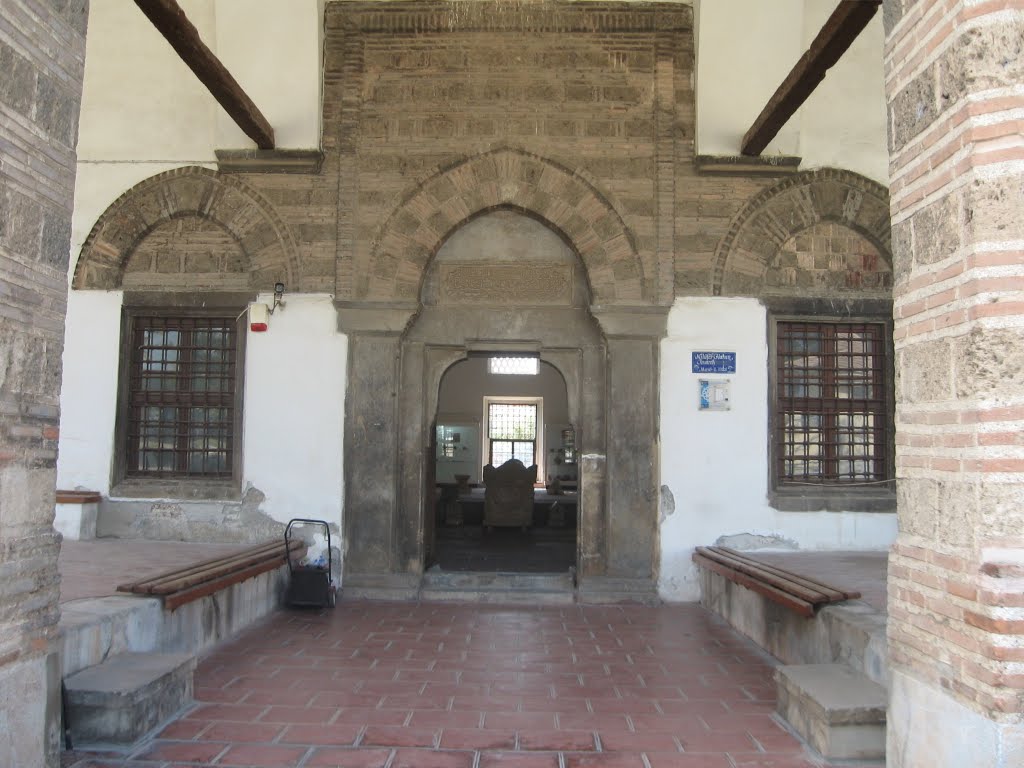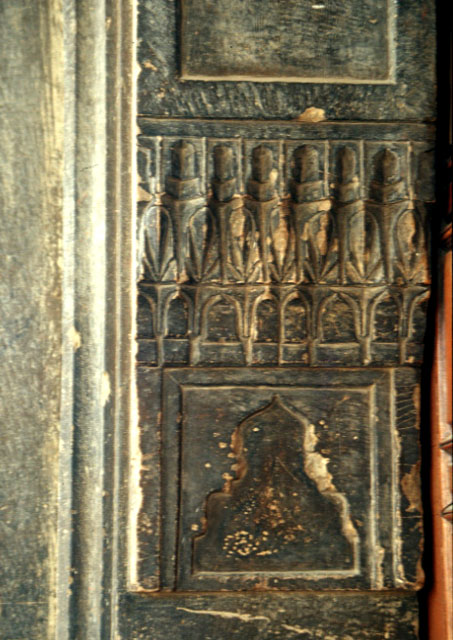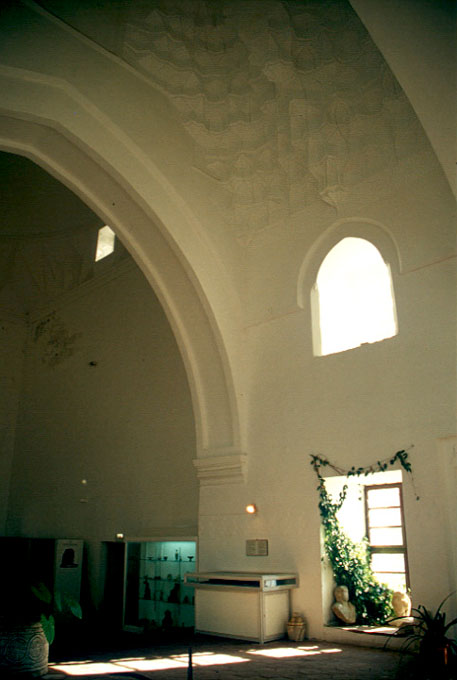Nilüfer Hatun Imareti on:
[Wikipedia]
[Google]
[Amazon]
Nilüfer Hatun Imareti ( Turkish for "''Nilüfer Hatun's Soup Kitchen''"), a convent annex hospice for 

 The Imaret is built in single courses of stone alternating with four courses of bricks, its vaults and domes covered with ceramic tiles. The building is preceded by an open ended porch of five bays, with five arches in front and two on either side, carried by a succession of alternating piers and columns. The central bay is surmounted by a small dome, while the four side bays are covered with flat topped cross vaults. Inside, the main hall is a square surmounted by a lofty dome carried on the belt of Turkish triangles. On either side there are two large rooms with much lover domes; these have large , or hearths, and were used as both kitchens and dormitories. In front of the main hall is another hall of similar size divided into two sections by a great arch; this served as a mescit, as evidenced by the mihrab niche in the south wall.
The Imaret is built in single courses of stone alternating with four courses of bricks, its vaults and domes covered with ceramic tiles. The building is preceded by an open ended porch of five bays, with five arches in front and two on either side, carried by a succession of alternating piers and columns. The central bay is surmounted by a small dome, while the four side bays are covered with flat topped cross vaults. Inside, the main hall is a square surmounted by a lofty dome carried on the belt of Turkish triangles. On either side there are two large rooms with much lover domes; these have large , or hearths, and were used as both kitchens and dormitories. In front of the main hall is another hall of similar size divided into two sections by a great arch; this served as a mescit, as evidenced by the mihrab niche in the south wall.
dervishes
Dervish, Darvesh, or Darwīsh (from ) in Islam can refer broadly to members of a Sufi fraternity (''tariqah''), or more narrowly to a religious mendicant, who chose or accepted material poverty. The latter usage is found particularly in Persi ...
, now housing the Iznik Museum in İznik
İznik () is a municipality and district of Bursa Province, Turkey. Its area is 753 km2, and its population 44,236 (2022). The town is at the site of the ancient city of Nicaea, from which the modern name derives. The town lies in a fertile ...
, Bursa Province, Turkey. This elegant building was erected in 1388 for Murad I
Murad I (; ), nicknamed ''Hüdavendigâr'' (from – meaning "Head of state, sovereign" in this context; 29 June 1326 – 15 June 1389) was the sultan of the Ottoman Empire from 1362 to 1389. He was the son of Orhan Gazi and Nilüfer Hatun. Mura ...
who dedicated it to his later mother Nilüfer Hatun.
During Murad's reign Nilüfer s recognized as Valide Hatun
Khatun ( ) is a title of the female counterpart to a khan or a khagan of the Turkic Khaganates and in the subsequent Mongol Empire.
Etymology and history
Before the advent of Islam in Central Asia, Khatun was the title of the queen of Bukhara. A ...
, the first in Ottoman history to hold this title, and when she died she was buried beside her consort Orhan Gazi
Orhan Ghazi (; , also spelled Orkhan; died 1362) was the second sultan of the Ottoman Empire from 1323/4 to 1362. He was born in Söğüt, as the son of Osman I.
In the early stages of his reign, Orhan focused his energies on conquering most ...
in Bursa.

Architecture

 The Imaret is built in single courses of stone alternating with four courses of bricks, its vaults and domes covered with ceramic tiles. The building is preceded by an open ended porch of five bays, with five arches in front and two on either side, carried by a succession of alternating piers and columns. The central bay is surmounted by a small dome, while the four side bays are covered with flat topped cross vaults. Inside, the main hall is a square surmounted by a lofty dome carried on the belt of Turkish triangles. On either side there are two large rooms with much lover domes; these have large , or hearths, and were used as both kitchens and dormitories. In front of the main hall is another hall of similar size divided into two sections by a great arch; this served as a mescit, as evidenced by the mihrab niche in the south wall.
The Imaret is built in single courses of stone alternating with four courses of bricks, its vaults and domes covered with ceramic tiles. The building is preceded by an open ended porch of five bays, with five arches in front and two on either side, carried by a succession of alternating piers and columns. The central bay is surmounted by a small dome, while the four side bays are covered with flat topped cross vaults. Inside, the main hall is a square surmounted by a lofty dome carried on the belt of Turkish triangles. On either side there are two large rooms with much lover domes; these have large , or hearths, and were used as both kitchens and dormitories. In front of the main hall is another hall of similar size divided into two sections by a great arch; this served as a mescit, as evidenced by the mihrab niche in the south wall.
Uses and restoration
The building originally served as a hostel for the Ahi Brotherhood of Virtue. This was a religious and fraternal society formed by the craft guilds inAnatolia
Anatolia (), also known as Asia Minor, is a peninsula in West Asia that makes up the majority of the land area of Turkey. It is the westernmost protrusion of Asia and is geographically bounded by the Mediterranean Sea to the south, the Aegean ...
during the Seljuk period. Ibn Battuta also wrote about the hospitality her received at one of the Ahi lodges in Anatolia.
Nilüfer's foundations was later used as an imaret, or refectory, serving free food to the poor of Iznik. The building was abandoned for many years but was restored in 1955.. Today it houses the Iznik Museum, with archaeological and ethnological collections, including an exhibition of the famous Iznik kilns.
See also
*Ottoman Empire
The Ottoman Empire (), also called the Turkish Empire, was an empire, imperial realm that controlled much of Southeast Europe, West Asia, and North Africa from the 14th to early 20th centuries; it also controlled parts of southeastern Centr ...
* Nilüfer Hatun
*Murad I
Murad I (; ), nicknamed ''Hüdavendigâr'' (from – meaning "Head of state, sovereign" in this context; 29 June 1326 – 15 June 1389) was the sultan of the Ottoman Empire from 1362 to 1389. He was the son of Orhan Gazi and Nilüfer Hatun. Mura ...
*Ottoman Architecture
Ottoman architecture is an architectural style or tradition that developed under the Ottoman Empire over a long period, undergoing some significant changes during its history. It first emerged in northwestern Anatolia in the late 13th century an ...
References
{{DEFAULTSORT:Nilufer Hatun Imareti Museums in Turkey Imarets Buildings and structures of the Ottoman Empire